The ancient history of the Aztec civilization is one of the most fascinating historical subjects, and for numerous reasons. Still largely shrouded in mystery, this colorful, complex culture was one of the crucial stages of all Mesoamerican civilizations and continues to be a well of new knowledge. Alas, the expansion of modern European nations brought an abrupt and inglorious end to the Aztecs. In just a few years, this ruling Mesoamerican force fell completely under the rule of the Spanish Empire. Nevertheless, the European conquerors brought to the light of the world many unique aspects of this civilization and human sacrifice was one of them. While the Spanish conquistadors were appalled by the viciousness and the extent of the Aztec violence and mass human sacrifice, for the majority of Mesoamerican cultures this was an everyday occurrence, and for some a necessity. Today we are descending into the brutal traditions of Aztec violence. It’s about to get bloody!
The Origins Of Aztec Violence
Mesoamerica is a historic, geographic, and cultural region of North America that spans roughly from modern day central Mexico through Belize, El Salvador, Guatemala, Nicaragua, Honduras, and Costa Rica . Before the arrival of the conquistadors from the Spanish Empire, this region was the home of many thriving cultures for well over a millennia.
In fact, some of the earliest cultures developed as early as 7000 BC, marked by a very early transition from the hunter-gatherer lifestyle into one of sedentary agriculture. The Valley of Mexico was arguably the central point of the Mesoamerican region, and subsequently the home of the Aztecs. And even though we will focus on the rituals of Aztec violence and sacrifice, we need to note that this practice is not exclusive to them.
The truth is that human sacrifice was present in many pre-Columbian Mesoamerican cultures – if not all of them. Archaeological and other evidence strongly supports this claim, and it goes back as far as the Olmec Civilization in 1200 BC, and even beyond that. The cultural and spiritual predecessors of the Aztecs, the Toltecs, also practiced human sacrifice, as did the Mayans and the Tarascans.
By the time of the Spanish arrival, the Aztecs were at a highly developed cultural stage, and human sacrifice rituals were fully established, regular, and took place on a massive scale. Even the earliest Spanish accounts, written by friars, explorers, and officials, all mention the barbaric human sacrifice and rampant Aztec violence – something the Europeans were not accustomed to seeing in such a manner.
In general, what was quickly obvious is the fact that sacrifice – in the purest sense of the word – was critical to the Aztecs. In many ways they centered their everyday activities, their religious beliefs, and the well-being of their entire populace around sacrifices. The theme of sacrifice was closely woven into every aspect of their culture – beginning with their gods and their myths.
Aztec legend states that all the gods sacrificed themselves so that humans could live. With that as the basis, Aztecs believed that all forms of sacrifice involving blood were for the wellbeing of the people. It seems that over the centuries of practicing human sacrifice that the blood, gore, and suffering were no longer considered as taboo, and were a normal occurrence. However, even if this statement is not correct, sacrifice was still accepted as a necessity.
The Aztec belief was centered on the view that the gods are continuing their sacrifice and keeping the whole universe sustained. Thus, the performance of human sacrifice was considered as a “returning of the debt” to the gods and was appropriately called nextlahualli (debt-payment).
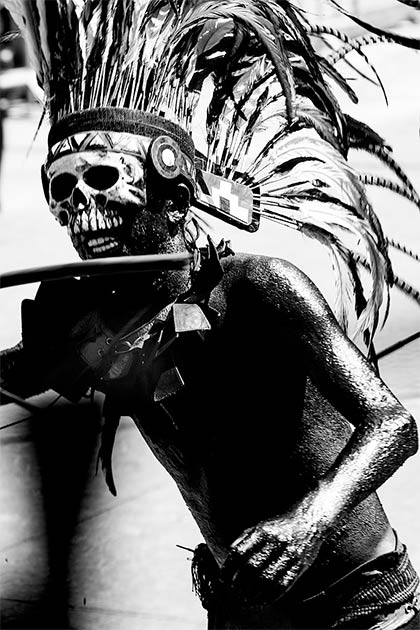
Even today in Mexico, as this image from early 2020 AD shows, Mesoamerican peoples continue to “celebrate” the pre-Hispanic “skull Aztec” street rituals just like the Aztecs did so long ago. (DanielElisalde1 / CC BY-SA 4.0 )
Returning the Debt to the Gods of the Universe
What many of the early European explorers discovered is the fact that the Aztecs were very willing to part with everything they had. The indebtedness to the gods was one of the major aspects of their entire civilization: offerings were made on many levels, and the sacrificing of human lives was the highest possible offering. The commoners would gladly offer their valuables: Aztec temples were crammed full with gold and precious items dedicated to the gods. What’s more, the common citizen would often perform self-sacrifice on a smaller scale: flesh was pricked with Agave thorns, or various parts of the body were cut to release blood, including tongues, ears, and genitals. It was not uncommon for Aztec people to cut their genitals and draw blood. In their mythology, it was the god Quetzalcóatl who took blood from his own genitals in order to give the life to humanity.
In Aztec life human sacrifice was performed often and regularly. And it was almost always performed as an elaborate and guided ritual. Those who were to be sacrificed were often captives – possibly enemy warriors or other people who became prisoners of war. At other times, the victims were chosen specifically for this role, sometimes becoming the embodiment of a certain deity.
What is interesting is the fact that many of the Aztec enemies who were captured shared some or many of the Aztec beliefs. Thus, they understood the “importance” of their role as a human sacrifice. Moreover, in many rituals the victims would hear the many petitions of people that they were to deliver to the gods, bless children, and greet the onlookers, and so on.
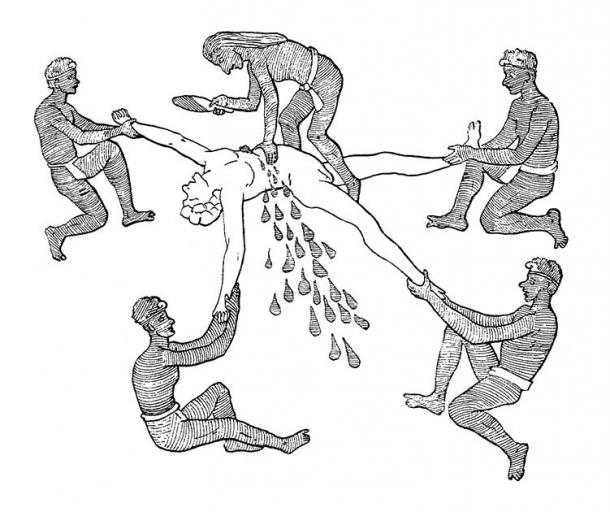
The highest form of Aztec violence involved human sacrifice and this scene shows just one example of how humans were killed to appease the gods. ( Erica Guilane-Nachez / Adobe Stock)
Extracting the Fragment of the Sun’s Heat
The extraction of the heart was the most common sacrifice method. This is because the Aztecs believed that the human heart was the “seat” of the person, and also a fragment of the sun’s heat. In most cases, this kind of sacrifice was performed at the top of a traditional Aztec temple. Built in a pyramid form, this kind of temple was marked by a very long flight of stairs, and a great platform on top. There, five priests would usually perform the ritual: four priests to hold the victim by his limbs, while the fifth priest used a ritual flint knife to cut open the abdomen, and then reaching with his hand through the diaphragm and extracting the heart.
In many cases, it is reported that the heart extracted in this way would often still be beating in the priest’s hand. The heart would then be placed in the highly important chacmool, an elaborately carved altar-like stone vessel, which held a hole for the many hearts. The head was in many cases severed, and along with the body, hurled down the enormous stairs towards the gathered masses.
During the sacrifice ritual itself, the commoners gathered in the plaza below the temple stairs would also participate. They would stab, cut, and prick themselves, drawing blood as a sign of religious self-sacrifice. It is interesting to note that the sacrificed victim was in fact revered. However, if those chosen as victims failed to complete their role, perhaps out of fear of death, they would be severely punished and dishonored, suffering an even more gruesome death, all the while being chastised and mocked for “insulting the gods.” Due to this, some chosen victims would be eager to be sacrificed, as was discovered by early Spanish explorers: some victims that they released rejected their newly found freedom, and adamantly requested to be sacrificed to the gods.
Upon the sacrificing of a person, their body was hurled down the many steps of the stairs. The internal organs were then fed to the wild animals in the zoo: Aztecs raised many predators in captivity, either for gladiatorial events or for animal sacrifices. The raising of jaguars, eagles, dogs, deer, and similar animals have all been documented.
The head of the slain victim was always displayed on a tzompantli, a special skull rack that displayed the numerous heads of victims and slain enemies. The flesh of the body was oddly enough consumed by select persons of society. Consumption of flesh was not the usual practice. It was done only in special rituals and to honor certain deities. The choicest portions of the flesh were given to the exalted warrior who captured the sacrificed victim, to victors of gladiatorial combat, or other prominent members of society.
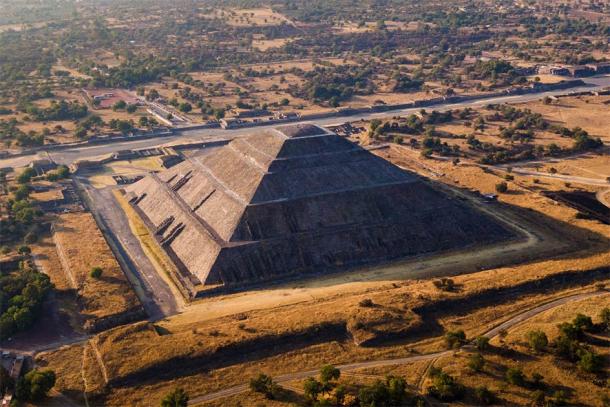
Pyramid of the Sun in the ancient Aztec city of Teotihuacan, Mexico, where human heads and bodies once rolled and tumbled down a long flight of stairs to the waiting crowd. ( R.M. Nunes / Adobe Stock)
Praising Their Lord, The Flayed One
Sacrifices were not always the same. While the ritual removal of the heart on the top of the temple was the most usual practice, other forms also existed, often reserved for sacrifices to certain gods. There was sacrifice through gladiatorial combat, either against animals or other warriors; there was sacrifice by drowning, by burning, or by being flayed alive.
However, the most interesting form of Aztec sacrifice was through the popular Mesoamerican ball game called ōllamaliztli or tlachtli. This unique sport was present in many Mesoamerican cultures and the Aztecs placed a big emphasis on it. Needless to say, the players involved in ritual tlachtli matches were greatly motivated to win. Because if they didn’t they were sacrificed to the gods!
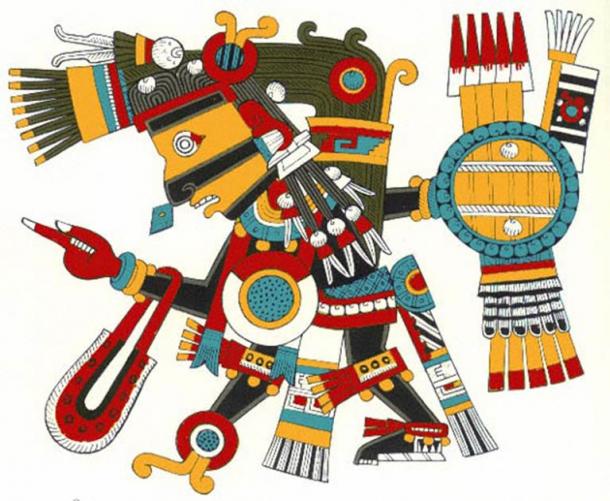
The god Tezcatlipoca in Aztec belief was responsible for creating war and as the source of food and drink for all the other gods. ( CC BY-SA 3.0 )
Tezcatlipoca was one of the central figures of the Aztec pantheon. Considered as their most powerful god, Tezcatlipoca was the god of destiny, of north, sorcery and night. His name is translated as the “smoking mirror” or “obsidian.” In Aztec belief, this god was responsible for creating war, and as a source of food and drink for all the other gods.
Considered as the all-powerful, all-seeing, and all-knowing god, Tezcatlipoca played an extremely important role in Aztec mythology. And those sacrificed to Tezcatlipoca suffered a particularly gruesome and unfair death. In accordance with the nature of this god, the victim was sacrificed in gladiatorial combat. However, the odds were greatly against him. The victim was tied to a huge stone in the ring, and armed with a mock weapon, a club with feather “spikes.” Fighting against him were four experienced, fully armed Aztec warriors.
Another way of sacrificing to Tezcatlipoca was during the Aztec month of Toxcatl, which in their calendar corresponded to roughly to May 5th to 22nd. A chosen victim was presented as the presence of Tezcatlipoca on earth. He was disguised as a god, revered, and given lavish gifts, including women, food, and indulgences of all sorts. However, when the month ended, he was sacrificed to the god.
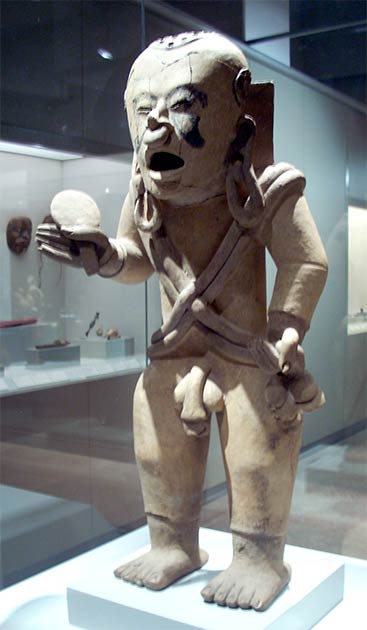
The god Xipe Totec was known as “Our Lord the Flayed One,” and figured prominently in Aztec violence rituals and sacrifices. This ceramic figure dates to 100-400 AD. (Simon Burchell / CC BY-SA 3.0 )
Xipe Totec was another crucial deity for the Aztecs. As the god of rebirth, the seasons, craftsmen and agriculture, Xipe Totec held a very important place in the Aztec mythology. His name translates to “Our Lord the Flayed One,” and he was represented as a flayed man.
And when it came to sacrificing to Xipe Totec, the fate of the victims was the most gruesome process of all. During the month of Tlacaxipehualiztli (from February 22nd to March 13th), Xipe Totec was especially worshiped. The person who was chosen as a sacrifice would represent the god himself for 40 days: they would dress and live as the god himself. However, on the day of the sacrifice they met their vicious fate: the person was flayed alive. Their skin was then worn by another person who would travel around the city and gather presents and bless citizens. The flayed victim was then sacrificed by having their heart removed, their body dismembered, and the body parts divided for consumption. Not the best of ways to go, right?
It is important to remember that the Spanish conquerors often blew things out of proportion, and greatly increased the numbers of sacrificed victims during these sacrificial rituals. For example, one larger-than-life claim states that the Aztecs sacrificed up to 84,000 prisoners of war during one period of sacrifices. These increased numbers were largely used to “demonize” the Aztecs and give the Spanish conquest more credibility and excuse. But even so, the degree and frequency of Aztec violence and blood thirst was mostly true. And what you have read here is certainly what happened for many centuries.
Fun, Games, and Gruesome Death
In the 21 st century AD, culture and civilization have ascended to a much greater height than just a couple of centuries before. Violence in most of the world’s nations is not too common for an everyday person.
But while we might flinch and cringe at the sight of bloodshed and death, that doesn’t have to mean that certain ancient cultures did so too. The Aztecs and Aztec violence are the perfect example – death in the most gruesome ways imaginable was as common to them as a football match is to us.
And it is possible that in such death they saw some greater religious meaning: as long as they were on the safe side of the blade!
Top image: A chacmool at the Templo Mayor (Greater Temple) archaeological site in Mexico City. Aztec violence and the use of the chacmool was a fundamental aspect of this culture. The hole in the belly of the chacmool was where the hearts of sacrificed victims were placed. Source: Miguel / Adobe Stock
References
Koch, P. 2015. The Aztecs, The Conquistadors, and the Making of Mexican Culture. McFarland.
McKinley, H. 2015. Myths of the Aztecs. Cavendish Square Publishing.
Rodríguez-Alegría E. and Nichols, D. 2017. The Oxford Handbook of the Aztecs. Oxford University Press.
Smith, M. 2013. The Aztecs. John Wiley & Sons.
Related posts:
Views: 0
 RSS Feed
RSS Feed
















 December 6th, 2020
December 6th, 2020  Awake Goy
Awake Goy  Posted in
Posted in  Tags:
Tags: 
















